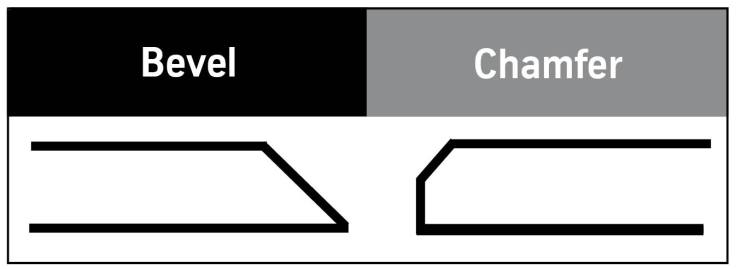A common practice in parts manufacturing is to reduce the chance of damage or injury caused by sharp corners of the part. To solve this problem, the mechanic removed part of the 90-degree angle and created a chamfer, also called a bevel. Although the terms “bevel” and “chamfer” tend to be interchanged in practice, there is a clear difference between the two. Let’s take a moment to examine the difference between bevel and chamfer, and see how CNC machining uses these features when manufacturing parts.
What Is Bevel?
A bevel is a sloped edge that is not perpendicular to the object surface. Bevel is the more common term in bevel and chamfer. Although these two terms are usually interchangeable, there is a difference between them in a technical context.
The bevel is the inclined edge between the two main surfaces of the part, which is convenient for connecting with the other surface. The bevel angle can be measured at any angle other than 45 degrees, and they help improve wear resistance, safety and aesthetics. Many cutting tools are made with beveled edges. Furniture such as glass table tops and mirrors are also made of beveled edges to prevent cuts.
What Is Chamfering?
Unlike the hypotenuse that connects one part to another, the chamfer transitions between two right-angled surfaces of the same part. Unlike a bevel, the chamfer is always at a 45-degree angle. Chamfering can remove the sharp edges of the 90-degree angle of the part to prevent injuries during handling. Chamfering can also protect the corners of the part from damage, thereby improving the overall integrity of the part.
The term is commonly used in manufacturing and mechanical engineering. Tools such as chamfering cutters and chamfering planes can also be used to make chamfers. The chamfered edges are used for aesthetic as well as non-aesthetic purposes. In addition to aesthetic purposes, chamfered edges are used for parabolic glass mirror design and printed circuit board design. Machinists will use chamfer cutters or “tools” when milling parts to create bevels or chamfers in machined parts. Beveling may require more passages to complete, and usually requires a larger area to be cut than chamfering, but this is subjective. In addition, the double-chamfer end mill can cut chamfers on the top and bottom of the workpiece without turning the workpiece.

Difference Between Bevel And Chamfer
Definition
The bevel is the hypotenuse between the two main faces.
A chamfer is a cut that usually makes a 45° angle to the adjacent main face.
Tool
The bevel can be made with the bevel tool.
You can use the chamfer tool to make chamfered edges.
Internal
The inside of the bevel will be a rhombus.
The inside of the chamfer will be an octagon.
Connotation
Beveling does not necessarily mean cutting.
Chamfering means cutting.
The Cost Of Adding Extra Features To The Design
The reasons for using bevels and chamfers to protect parts and their users are obvious. However, these features are usually more for aesthetics than function, and they increase the production cost of the part.
Some practical questions to ask before including bevels or chamfers in your design:
- Does the part need to be inclined or chamfered to function?
- Is a bevel required for safety purposes?
- How to check the tolerance of bevel or chamfer?
- Is this a cost-effective feature added to the design?
Features such as bevels and chamfers require additional time during the manufacturing process. When multiplied by the number of parts produced, even a 10% increase in time for each part will quickly add up. If irrelevant functions do not have any necessary functions or purposes, please reconsider them. The specified tolerances for bevels or chamfers should also undergo some review. The machine shop needs more time to manufacture and check tighter tolerances, which also increases the cost of parts production.
Designing chamfers into the features of the part instead of smoothing the corners will reduce the cost of manufacturing the part. Chamfering will reduce the time required to cut right angles in the part and allow the use of cheaper tools. The internal chamfer also helps prevent dust and waste from accumulating on the corners of the part.
Considering all these issues before designing bevels or chamfers into the part provides advantages. If the design does not require these functions, excluding them will simplify manufacturing, saving time and money. On the other hand, if the design really needs them, it can still reduce the impact on production time and cost. One approach is to provide large tolerances and simplify the manufacturing of bevels and chamfers if precise dimensions are not critical. Another option is to completely remove the chamfer feature from the CAD model and add a note on the 2D drawing, instructing the machine shop to “remove all sharp edges.”



Inside of a chamfer has 5 sides, therefore it is a pentagon.